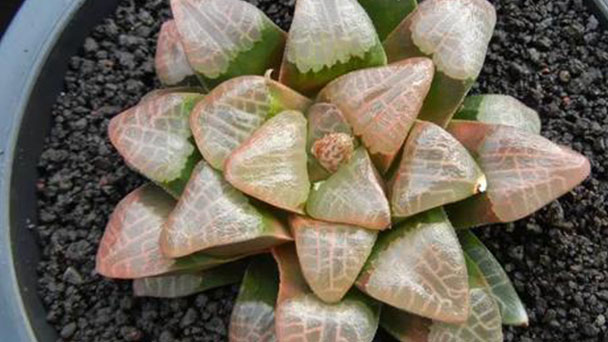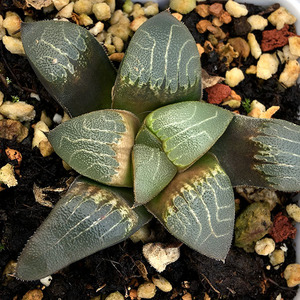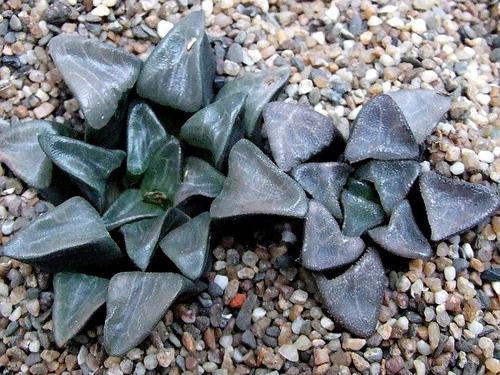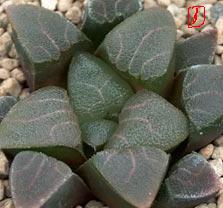Haworthia bayeri profile
Written by Maggie
Aug 24 2021

Haworthia bayeri is a perennial plant of the genus Amulus in the family Aphosaceae. Haworthia bayeri has no stem, fleshy leaves were arranged in rosette, leaves hypertrophic, shell-like, rough leaves, a small granular protuberance, dark grayish green leaves, slightly transparent, a grayish white reticulate lines. Inflorescences are loose racemes, florets tubular, grayish white, with dark longitudinal stripes.
Haworthia bayeri picture

Morphological characteristics of Haworthia bayeri
Haworthia bayeri has no stem, fleshy leaves were arranged in rosette, leaves hypertrophic, shell-like, rough leaves, a small granular protuberance, dark grayish green leaves, slightly transparent, a grayish white reticulate lines. Inflorescences are loose racemes, florets tubular, grayish white, with dark longitudinal stripes.
The ecological habits of Haworthia bayeri
Haworthia bayeri prefers warm, dry and semi-cloudy environments. haworthia bayeri is afraid of high temperature and bright light. Haworthia bayeri requires a loose, good drainage medium. The temperature in winter is not lower than 10℃. In summer, astigmatism shading maintenance is carried out, and watering is controlled. In autumn, the shading net can be removed to choose a place with better lighting. In winter, the light intensity is low, and direct light maintenance can be selected.
Growing methods of Haworthia bayeri
Haworthia bayeri is a shallow-rooted pulpy plant. Potted should not be too deep, with drainage good leaf soil and coarse sand mixed soil had better. Keep it slightly moist during the growing period, but no water in the basin. When the air is too dry, it can spray water to increase the air humidity and make the leaves full and full. Fertilizer 1 time a month, or can be dried cow dung processing granular organic fertilizer. Summer high temperature, winter low temperature and dormant period should be dry, strict control of watering. If the light is insufficient, easy generation is in vain, when midsummer light is too strong, should shade appropriately.
There are seventy-two variations in the hybridization between normal and normal because each parent has a number of characteristics. For example, silver has the characteristics of big kubo plant shape, peach-shaped leaves, wart spots, sunburn green into purple red, and silver longevity hybridization may only take one of the hybridization, may also take several characteristics of hybridization, so the appearance of longevity out of hybridization is variable.
Except for the normal longevity, the hybrid longevity is not a fixed combination, and it should be noted that the longevity of the species can not be determined by the specially selected longevity chart.

Haworthia Bayeri's propagation
Haworthia bayeri propagation should be made by ramets and cuttings.
Division
All the year round can be carried out Haworthia bayeri division, often in the spring 4-5 months when changing the basin, the mother plant from inside the basin, peel off the surrounding young plants, potted namely.
Cuttings
Leaves of Haworthia bayeri are mainly inserted, cutting the leaves after a little dry cuttings, otherwise the incision is easy to rot, affecting the survival rate. It can also remove the top of the growth point to promote the leaf axillary germination of new seedlings after cuttings.
Disease control of Haworthia bayeri
Haworthia bayeri basically has no pests and diseases, mainly pay attention to not rot root, rotten leaves, insolation lead to plant death is good, summer most of the domestic areas need appropriate shading, you can choose to use a shading net or placed in a place with appropriate astigmatism irradiation intensity conservation.
But sometimes occur root rot and anthrax harm, with 50% of the fungus Dan 800 times the liquid spray. Insects have scale insect harm, with 40% diego emulsion 2000 times liquid spray kill.
Haworthia bayeri varieties
Haworthia bayeri J.D.Venter & S.A.Hammer: is a retuse-leaved species with variable white strips across the olive-green to red leaf surfaces. Distribution: Western Cape, Little Karoo, from Oudtshoorn in the west till Uniondale in the east.
Haworthia bayeri f. variegata hort.: variegate form.
Haworthia bayeri cv. Kelikete: This is one of the best clones whit beautiful reticulate patterning or and extra shiny almost glassy surface.

Latest Updated
- Benefits of Bugleweed - 7 Science-backed Health Benefits
- Bugleweed Dangers & Side Effects - Is It Poisonous?
- How to Plant Evergreen Trees - What You Should Know
- When to Plant Evergreens - Grow Guide for Evergreen Trees
- 12 Wonderful Evergreen Shrubs for Your Garden
- 12 Popular Evergreen Plants with Pictures for Beginners
- When And How To Prune A Lilac Bush Like a Pro
- How to Grow & Care for Lilac Vine (Hardenbergia Violacea)
- Japanese Lilac Tree (Syringa Reticulata) Care & Propagation Guide
- Shumard Oak Pros and Cons - What to Know
Popular Articles
- Winter maintenance of Antirrhinum Majus
- How to Grow Terminalia Mantaly Tree
- How to Grow and Care for Crossostephium Chinense
- How to grow Antirrhinum Majus in spring
- Peristeria Elata (Dove Orchid) Profile: Info & Care Guide
- Underwatered Snake Plant (Sansevieria Trifasciata) - Signs And How To Fix
- How to Care for Brazilian Jasmine Plant (Mandevilla Sanderi)
- How to Grow & Care for Graptopetalum Purple Delight in Summer
- Rosa Chinensis (China Rose): Plant Growing & Care Tips
- How to Care for Baby Sun Rose (Aptenia Cordifolia)